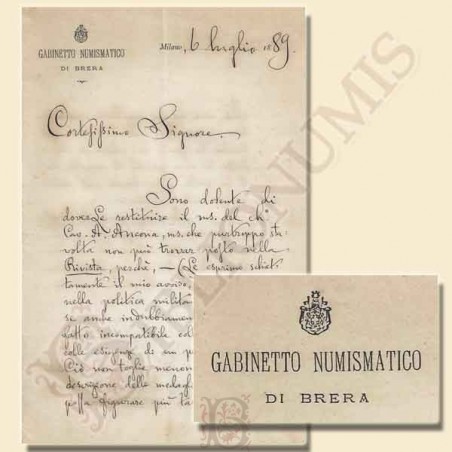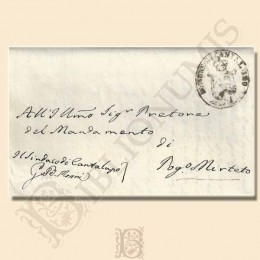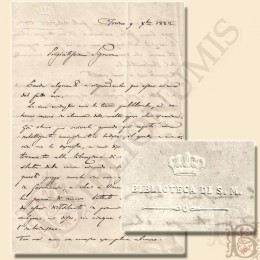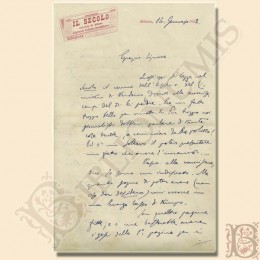Solone Ambrosoli (1851-1906). Born in Como on 8 October 1851, he was a man of profound and vast culture, a skilled writer, as we see in all his copious production of scientific and numismatic texts, but he was also a popularizer, a translator, a man of letters and a poet . Everyone agrees in describing him as a good and kind man, a model of citizen and scientist. His wealthy family played a fundamental role in his education and studies: his paternal ancestor Francesco Ambrosoli was a well-known scholar and philologist.
Solone Ambrosoli attended several Italian universities and graduated in Parma in 1878. He began as a collector so much so that his first publication, in 1878, referred to his coins: Italian mints represented in the numismatic collection of Solone Ambrosoli, student in Law, the The work was published in second edition in 1881 in one hundred and fifty numbered copies with eight photographic plates. In 1878 he was called to be part of the commission charged with reorganizing the Como Museum. In 1878 Solone Ambrosoli wrote his first poetic work, entitled Starting from New York, which takes its cue from the trip he made to the United States in 1873. The first poems composed by him converge in the collections Poems of 1880, Poetic Versions from Northern Languages and original poems of 1881 and original and translated poems published in 1882, all printed at the Carlo Franchi printing house in Como. Solone Ambrosoli dedicates himself above all to Scandinavian authors, but he also faces other poets such as the French Xavier Marmier, the American HW Longfellow, or the Germans Adalbert von Chamisso, Nokolaus Lenau and Heinrich Heine. His choices are always directed towards romantic poets similar to his way of feeling, who deal with the themes dear to him. The verses tell us about love, death, nature, beauty, political and social commitment. In 1893 Ambrosoli experimented with a new way of relating to poetry and published a translation by Bjarni Thòrarensen, one of the most representative Icelandic poets of the nineteenth century, which differs from the previous ones because it is made in prose and because it is accompanied by comments from literary criticism. by our numismatist.
Solone Ambrosoli also devoted himself to works of various kinds, which find inspiration in his numerous travels such as the report addressed to the Royal Ministry of Education, Division of Ancient Art, in which he carefully describes the main characteristics of all the famous places touched by the his trip to Athens and Constantinople in 1892, highlighting the cultural attractions, museums, monuments, artistic and naturalistic beauties. Special attention is paid to both public and private numismatic collections that he can visit personally. He also produced an interesting guide of the city of Athens, published in 1901 among the Hoepli Manuals. Also in this case, Ambrosoli's desire to acculturate as wide an audience as possible is evident, to use simple and captivating language, but also to be useful for scholars, providing an accurate bibliographic repertoire. This predisposition to the bibliographic collection gave rise to two essays. The first is dedicated to Gaeta, a Larian town near Acquaseria, where he bought a villa where he probably spent his summer holidays. We see reflected in this choice two aspects of Solone Ambrosoli's personality: the love for the Lario and the predilection for minor, humble themes, which however deserve to be valued and deepened. The essay consists of a meticulous collection of all the passages of books, cartography and texts in which the locality is spoken of. His other bibliographical work has as its object the figure of Giangiacomo de Medici, limited to the decade 1523-1532 in which he was castellan of Musso and reactivated the local mint. In 1881 Ambrosoli founded the Numismatic Journal in Como: a monthly periodical, of low cost, in which he published the studies carried out from 1881 to 1886, and called upon the best numismatists of the time to collaborate. The following year doubles the frequency with 24 numbers and the cost of the subscription rises to ten lire. In 1883, the third year of publication, the Numismatic Journal returned to 12 issues, bringing the pages from four to eight; sometimes two issues are published at once; with the doubling of the pages it becomes possible to publish articles of greater commitment. Among the collaborators we find famous names: the Gnecchi brothers, Costantino Luppi, Emilio Motta, Damiano Muoni, Girolamo and Umberto Rossi, Giuseppe Ruggero, Carlo Francesco Trachsel.
In the evolution of the Numismatic Journal between 1881 and 1887 we note the increase in the use of photographs and drawings, it becomes a magazine in line with the progress of the time, and the attention to the documents that increasingly accompany the texts of the articles related to ticks. The interest of the Gazzetta Numismatica was mainly directed to the Italian numismatics; Solone Ambrosoli was a forerunner in the study of Italian mints; his initiatives predate the intention of Vittorio Emanuele III to create the Corpus, an initiative that evidently attracted the interest of many numismatists on medieval and modern Italian coins given the importance of the promoter: Crown Prince and then King of Italy. Many studies relating to the Italian minor mints, published in the Numismatic Journal, are still the basis of our current knowledge. In 1887 Ambrosoli put an end to his publishing initiative by suspending the publication of the Numismatic Journal, which he had always directed, since together with other scholars and passionate collectors, he founded the Italian Numismatic Magazine, whose first issue was published in 1888 and of which Solone Ambrosoli was the first director. The RIN still bears the words “Founded by Solone Ambrosoli in 1888” on the title page. To encourage the involvement in the new publication of the most eminent numismatists and to facilitate its diffusion, the two numismatic periodicals that existed in Italy at that time ceased to be published: the Gazzetta Numismatica directed by Solone Ambrosoli published in Como and the Bulletin of Numismatics and Sfragistics for the history of Italy founded in 1882, jointly directed by Ortensio Vitalini and the canon Milziade Santoni, published in Camerino.
At the end of the 19th century, the new publication places Italian Numismatics in the European context. The RIN comes when some sisters had already existed for 50 years, such as the Revue Numismatique, French, from 1836, the Numismatic Chronicle, English, from 1838 (first since 1836 Numismatic Journal), the Revue Belge de Numismatique from 1842, however well in advance compared to numerous other initiatives that have arisen in European or non-European countries. From the beginning, the magazine presented photographic plates illustrating coins but also reproducing documents such as those of the Correggio mint; tables that even today, after more than a century, we can define beautiful. Solone Ambrosoli, in the "Preface" to the first issue of the RIN, sets out in detail the objectives of the new magazine: "... Periodic publication, which brings together the results of the investigations, makes known the new discoveries, gives notice of the writings disseminated in works of other subject or difficult to access ". Solone Ambrosoli directed the RIN for two years, from 1888 to 1889, during which the foundations of all future activity were laid; RIN is open to all aspects of ancient, medieval and modern numismatics, with particular attention to medals, not only from the glorious Renaissance and Baroque past, but also to the more recent ones of the Risorgimento and modern wars. Solone Ambrosoli remains on the Editorial Board and collaborates by sending articles, descriptions of closets and discoveries of coins and reviews, always with particular attention to medieval and modern coins. The management of RIN was immediately taken over by the Gnecchi brothers and in 1892, when the Italian Numismatic Society was established, Solone Ambrosoli was among the 42 founding members and was elected Councilor. It should be remembered that the SNI was established primarily to guarantee a definitive structure and a better assured life for the Italian Numismatic Magazine.
What were the commitments that prompted Solone Ambrosoli to abandon the direction of the RIN? Solone Ambrosoli had been appointed, by decree of 25 July 1887, curator of the Numismatic Cabinet of Brera, thus taking over from Bernardino Biondelli who died on 11 July 1886. On that occasion Ambrosoli generously donated his collection of coins to the Civic Museum of Como made up of about 1800 foreign coins and 1000 Italian coins representing 200 mints. Solone Ambrosoli, in his capacity as conservator of the numismatic collections, was placed directly under the director of the Brera art gallery, so, not having administrative autonomy and financial resources, he could not deal with important numismatic purchases nor could he alone prepare for the definitive drafting of the catalog. general of the medal table; he carried out almost all of his activity as a scholar numismatist on his own account and as a teacher.
In 1891 he had obtained free lectures in Numismatics at the Royal Scientific-Literary Academy in Milan and in 1893 he held a free course of lessons which he had to interrupt, having been sent on a mission to Catanzaro to draw up the Catalog of that Museum, published in two parts in 1894. The opening of his numismatics course entitled On numismatics as an autonomous science, read on January 25, 1893, was published in the RIN, Vol. VI (1893), pp. 21-35. In the first year of the new century Serafino Ricci came to the Brera medal table to assist in the work of Solone Ambrosoli, who in the meantime had become director.
In 1905 the first difficulties arose for Solone Ambrosoli who in fact asked for leave for health reasons. The scientific activity of Solone Ambrosoli turned mainly to medieval numismatics; initially published in "his" Numismatic Journal and then systematically for 18 years in the RIN. He published numerous storerooms, collected the bibliography of various mints, illustrated and interpreted many unpublished and unknown coins, correcting old errors published and then repeated. His activity was more intense, however, in the field of dissemination, we recall his manuals: Manual of numismatics, Milan Hoepli 1891, with a second edition in 1903 and a third edition in 1904. The manual was then taken up by Francesco Gnecchi and arrived in 1922 in the sixth edition; edition that was republished anastatically in 1975 by the Cisalpino-Gogliardica Publishing Institute in Milan. Hoepli Manual of Greek Coins, Milan 1899 taken up by Serafino Ricci with a second edition in 1917; this edition was also republished anastatically in 1979 by the Cisalpino-Gogliardica Publishing Institute.
Also among the Hoepli manuals, Atlantino of modern papal coins, in aid of Cinagli, Milan 1905 and the modern numismatic Atlas, Milan 1906. Ambrosoli participated in the International Congress of Historical Sciences in Rome on April 4, 1903, presenting a communication, published in the Acts, About the so-called "restitutions" of Gallienus or Philip, in which he identified a new emperor subject to monetary restitution: Traiano Decio.
Solone Ambrosoli is remembered by Serafino Ricci, who knew him well, as a person who did not like teaching: perhaps he did not believe in its effectiveness for the diffusion of numismatics and therefore preferred to devote himself to the creation of manuals, which he considered more valid, or his shyness and his innate opposition to appearing in public led him to favor research work and publishing. Ricci remembers him as a person available, kind, caring towards all those who asked him for advice, who consulted him on scientific matters and who for whatever reason resorted to him: he could not say no to anyone; with great care he worked from morning to evening in “his” museum without a moment's pause, even to the detriment of his own health.
Solone Ambrosoli died in Milan on 27 September 1906 and was succeeded by prof. Serafino Ricci. Immediately the Direction of the Museum intended to honor the illustrious deceased director with a monument and with writings on numismatics; this was carried out on the occasion of the first centenary of the Museum in May 1908. The ceremony took place on May 10 in the great Maria Teresa room at the Palazzo di Brera, Vittorio Emanuele III, in his dual capacity as King of Italy and President of the Society Italian Numismatics, he was officially represented by the Prefect of Milan. All the political and city authorities were also represented and other personalities were present: senators, deputies, numismatists, among the family members were present the widow and the brother of the deceased Hon. Dr. Francesco Ambrosoli. The bronze bust of Solone Ambrosoli by the sculptor prof. Antonio Ricci. The organizing committee had a medal coined in his honor on the model of Egidio Boninsegna, engraved by Angelo Cappuccio and made in the Johnson factory. The medal minted in silver and bronze bears the bust of Solone Ambrosoli on the right side and on the reverse, in fifteen lines, the inscription: A REMEMBER / DI / SOLONE AMBROSOLI / OF THE DISCIPLINES NUMISMATICHE / DOTTO INVESTIGATORE / GENIUS DISTRIBUTOR / CONSERVATORE DEL GABINETTO / NUMISMATICO DI BRERA / FROM 1887 TO 1906 / THE MANAGEMENT OF THE MEDALSER / THE ITALIAN NUMISMATIC SOCIETY / ADMIRATORS AND COLLEAGUES / IN THE CENTENARY OF THE MUSEUM / DEDICAN / 10 MAY 1908. The commemoration saw the interventions of Francesco Gnecchi to commemorate the centenary of the Numismatic Museum and by Serafino Ricci to commemorate the figure of Solone Ambrosoli. At the same time, the first two issues of RIN 1908 were published, again in honor of Solone Ambrosoli, gathered in a single volume of 342 pages, which opened by Ricci's interventions on the numismatic work of Ambrosoli and Francesco Gnecchi on the centenary of the Cabinet Numismatist of Brera, contain other 33 interventions by numismatists: among the Italians, Cunietti-Cunietti, Giuseppe Ruggero, Ortensio Vitalini, Ercole Gnecchi, Giuseppe Castellani, Giovanni Dattari, Nicolò Papadololi, Lodovico Laffranchi, Edoardo Martinori, Vincenzo Dessì, and, among the foreigners, Emilio Motta, Ernest Babelon, Alphonse de Witte, Arnold Luschin von Ebengreuth, Paul Bordeaux, Adrien Blanchet, Max Bahrfeldt, Jean N. Svoronos. The importance of the signatures are the testimony of the relationships and esteem that linked Solone Ambrosoli to the Italian and European numismatic world.
Amilcare Ancona (1839-1890). He was born in Rovigo, he fought in the campaigns of 1859. Employed at the Ministry of Public Education (1860), then at the Directorate of Public Education in Florence (1861). The Ancona was one of the most passionate Milanese collectors of the second half of the nineteenth century. His taste was eclectic and his collections embraced different branches, from prehistoric objects to documents of the national Risorgimento. In his home in Milan he had assembled an important museum, which featured Egyptian, Greek and Roman excavated objects, ancient marbles, coins and medals, autographs and documents. In his small villa in Precotto he had then formed a supplement to the museum in Milan, placing a quantity of marbles and ancient inscriptions there. In 1884 he sold his entire numismatic collection to the public enchantment in Milan, but then reconstituted it in the last years of his life.







